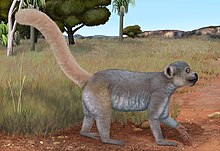Archaeolemuridae
| Monkey lemur | |
|---|---|
 |
|
| Life restoration of Hadropithecus stenognathus | |
 |
|
| Life restoration of Archaeolemur edwardsi | |
| Scientific classification | |
| Kingdom: | Animalia |
| Phylum: | Chordata |
| Class: | Mammalia |
| Order: | Primates |
| Suborder: | Strepsirrhini |
| Superfamily: | Lemuroidea |
| Family: |
†Archaeolemuridae Forsyth Major, 1896 |
| Genera | |
The monkey lemurs or baboon lemurs (Archaeolemuridae) are a recently extinct family of lemurs known from skeletal remains from sites on Madagascar dated to 1000 to 3000 years ago.
The monkey lemur family is divided into two genera (family: Hadropithecus and Archaeolemur) and three species. Despite their common names, members of Archaeolemuridae were not as closely related to monkeys as they were to other lemurs.
There are two species within the genus Archaeolemur: Archaeolemur edwardsi and the Archaeolemur majori. Recently, there have been findings of fossils in the north to north east of Madagascar. These findings of the Archaelolemur edwardsi fossils are enough to create an almost complete reconstruction of what the hands and feet looked like. These reconstructions indicate that the extinct lemurs did not climb very often and imply that they were much more at home on the ground. In fact, the indication is that they were more ground-oriented than most living strepsirrhines. They are not believed to have been exclusively terrestrial, but rather to have had a combined habitat of ground and arboreal life. A modest degree of curvature found in the remains support this idea. The hands and feet are very robust and large in size, but are very short and said to be closer to the likeness of a baboon's hand. The hind-limbs are also known to be short, which implies that the hands and feet are relatively short for the lemur's body weight. While the hands and feet of Archaeolemur may have a likeness to the hands of baboons, they are not considered to be similar to either baboons or other strepirrhines at all. Instead they are more akin to Mandrillus and macaques. Archaeolemur is unique in the combination of post-cranial features. The overall look of the lemur, beyond just the hands and feet, was a relatively short and stocky one which gave them limited leaping abilities. This indicates that the Archaeolemur may have inhabited large portions landscapes, which is consistent with its spread over practically the entire island of Madagascar. This implies they had a high tolerance for broad habitats. They are also known to be omnivores from the fossilized droppings of a younger individual. An imaging technique shows pictures of the mandibles, showing the bone structure of the mouth. Further studies on their enamel indicate that Archaeolemur also had the ability to exploit resources that may have been indigestible to other species, showing a great robustness in their dietary tracts as well. It comes as no surprise, then, that once humans migrated to Madagascar, Archaeolemur was able to outlive most of the other currently extinct species of lemur before finally also going extinct.
...
Wikipedia
